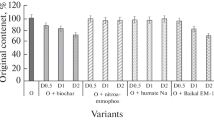Abstract
The effect of soil contamination with black oil added in amounts of 0.1, 0.5, 1.0, 2.5, 5, 10, 25, and 50% of the soil mass on the biological properties of ordinary and leached vertic chernozems, brown forest soils, and gray sands in the south of Russia was studied in a model laboratory experiment. It was shown that the soil contamination causes a drop in the catalase and dehydrogenase activities, the cellulolytic capacity, the number of Azotobacter bacteria, and the characteristics of the plant germination. The ordinary and vertic chernozems were more tolerant toward the contamination than the gray sands and brown forest soils. The changes in the biological soil properties in dependence on the degree of the soil contamination differed considerably for the soils with different properties (the chernozems, brown forest soil, and gray sands) and were similar for the soils with similar properties (the ordinary and vertic chernozems). One soil (the brown forest soil) could be more tolerant toward the contamination than another soil (the gray sands) at a given concentration of black oil (<2.5%) and less tolerant at another concentration of black oil (>2.5%). The ecologically safe levels of the soil contamination with black oil do not exceed 0.7% in the ordinary chernozems, 0.3% in the compact chernozems, 0.1% in the brown forest soils, and 0.06% in the gray sands.
Similar content being viewed by others
References
A. N. Gennadiev, I. S. Kozin, E. I. Shurubor, and T. A. Teplitskaya, “Dynamics of Soil Pollution with Polycyclic Aromatic Hydrocarbons and Indication of the State of Soil Ecosystems,” Pochvovedenie, No. 10, 75–85 (1990).
N. M. Ismailov, “Microbiology and Enzyme Activity in Oil-Polluted Soils,” in Remediation of Oil-Polluted Soil Ecosystems (Nauka, Moscow, 1988), pp. 42–56 [in Russian].
K. Sh. Kazeev, S. I. Kolesnikov, and V. F. Val’kov, Biological Diagnostics and Indication of Soils: Methodology and Study Methods (Izd. Rost. Gos. Univ., Rostov-on-Don, 2003), 204 pp. [in Russian].
N. A. Kireeva, E. I. Novoselova, and T. S. Onegova, “Catalase and Dehydrogenase Activities in Soils Polluted with Oil and Oil Products,” Agrokhimiya, No. 8, 64–72 (2002).
N. A. Kireeva, E. I. Novoselova, and F. Kh. Khaziev, “Carbohydrase Activity in Oil-Contaminated Soils,” Pochvovedenie, No. 12, 1444–1448 (1998) [Eur. Soil Sci. 31 (12), 1314–1318 (1998)].
S. I. Kolesnikov, K. Sh. Kazeev, and V. F. Val’kov, Ecological Consequences of Soil Contamination with Heavy Metals (Izd. SKNTs VSh, Rostov-on-Don, 2000), 232 pp. [in Russian].
S. I. Kolesnikov, K. Sh. Kazeev, and V. F. Val’kov, “Ecological Functions of Soils and the Effect of Contamination with Heavy Metals,” Pochvovedenie, No. 12, 1509–1514 (2002) [Eur. Soil Sci. 35 (12), 1335–1340 (2002)].
S. I. Kolesnikov, K. Sh. Kazeev, M. L. Tatosyan, and V. F. Val’kov, “The Effect of Pollution with Oil and Oil Products on the Biological Status of Ordinary Chernozems,” Pochvovedenie, No. 5, 616–620 (2006) [Eur. Soil Sci. 39 (5), 552–556 (2006)].
Methods of Soil Microbiology and Biochemistry, D. G. Zvyagintsev (Ed.) (Izd. Mosk. Gos. Univ., Moscow, 1991), 304 pp. [in Russian].
Yu. I. Pikovskii, “Transformation of Technogenic Fluxes of Oil in Soil Ecosystems,” in Remediation of Oil-Polluted Soil Ecosystems (Nauka, Moscow, 1988), pp. 7–22 [in Russian].
S. Ya. Trofimov, Ya. M. Ammosova, D. S. Orlov, et al., “Impact of Oil Contamination on the Soil Cover and Problems of the Development of Regulations on Oil Pollution of Soils,” Vestn. Mosk. Univ., Ser. 17: Pochvoved., No. 2, 30–34 (2000).
F. Kh. Khaziev, E. I. Tishkina, and N. A. Kireeva, “Influence of Oil Products on the Biological Activity of Soils” Biol. Nauki, No. 10, 93–99 (1988).
W. T. Frankenberger, Jr. Johanson, and J. B. Johanson, “Influence of Crude Oil and Refined Petroleum Products on Soil Dehydrogenase Activity,” J. Environ. Qual. 11(4), 602–607 (1982).
A. Popa, “Inductia Enzymalica in Sol ca lest Ecotoxicologic Pentru Poluanti Anorganici si Orsanici,” Stud. Univ. Babes-Bolyai. Biol. 1(45), 129–138 (2000).
B.-M. Wilke, “Effects of Non-Pesticide Organic Pollutants on Soil Microbial Activity,” Adv. GeoEcol. Reiskirchen, No. 30, 117–132 (1997).
Author information
Authors and Affiliations
Corresponding author
Additional information
Original Russian Text © S.I. Kolesnikov, V.G. Gaivoronskii, E.N. Rotina, K.Sh. Kazeev, V.F. Val’kov, 2010, published in Pochvovedenie, 2010, No. 8, pp. 995–1000.
Rights and permissions
About this article
Cite this article
Kolesnikov, S.I., Gaivoronskii, V.G., Rotina, E.N. et al. Assessment of soil tolerance toward contamination with black oil in the south of Russia on the basis of soil biological indices: A model experiment. Eurasian Soil Sc. 43, 929–934 (2010). https://doi.org/10.1134/S1064229310080107
Received:
Published:
Issue Date:
DOI: https://doi.org/10.1134/S1064229310080107




